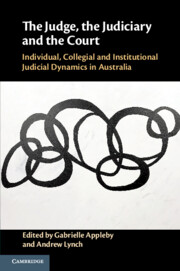 The Judge, the Judiciary and the Court
The Judge, the Judiciary and the Court Book contents
- The Judge, the Judiciary and the Court
- The Judge, the Judiciary and the Court
- Copyright page
- Contents
- Figures
- Tables
- Contributors
- Foreword
- Cases
- Part I The Judge, the Judiciary and the Court
- 1 The Judge, the Judiciary and the Court
- 2 Re-examining the Judicial Function in Australia
- 3 The Chief Justice
- Part II Debates and Challenges to the Judicial Role
- Part III The Judiciary as a Collective
- Part IV Perceptions
- Index
2 - Re-examining the Judicial Function in Australia
from Part I - The Judge, the Judiciary and the Court
Published online by Cambridge University Press: 04 May 2021
- The Judge, the Judiciary and the Court
- The Judge, the Judiciary and the Court
- Copyright page
- Contents
- Figures
- Tables
- Contributors
- Foreword
- Cases
- Part I The Judge, the Judiciary and the Court
- 1 The Judge, the Judiciary and the Court
- 2 Re-examining the Judicial Function in Australia
- 3 The Chief Justice
- Part II Debates and Challenges to the Judicial Role
- Part III The Judiciary as a Collective
- Part IV Perceptions
- Index
Summary
Australia has a uniquely developed constitutional discourse as to the nature of judicial power. However, this focus on constitutionality has at times tended to obscure a deeper reflection on the underlying concept of the scope of the judicial role. This approach elevates the permissible over the ideal.
It is against this context that this chapter presents a systematic and coherent articulation of the judicial function as a conceptual, rather than constitutional, inquiry. It argues that this function involves a unique institutional blend of dispute resolution and social governance. In the current Australian judicial environment, with its particular focus on efficiency and ‘collegiality’, this explicit recognition of the dualist nature of the judicial role is controversial but critical.
The chapter develops a taxonomy for the systematic characterisation of dispute resolution methods generally, which clearly delineates the judicial form of dispute resolution. It outlines how dispute resolution mechanisms can operate as tools of social governance and explores specifically how the judiciary operates s such an institution. The expansive articulation of function set out in this chapter invites a critical reflection of the limits, constraints, and purposes of the judicial role. The chapter concludes by exploring how this approach may better inform a number of issues facing the contemporary Australian judiciary
- Type
- Chapter
- Information
- The Judge, the Judiciary and the CourtIndividual, Collegial and Institutional Judicial Dynamics in Australia, pp. 22 - 49Publisher: Cambridge University PressPrint publication year: 2021
